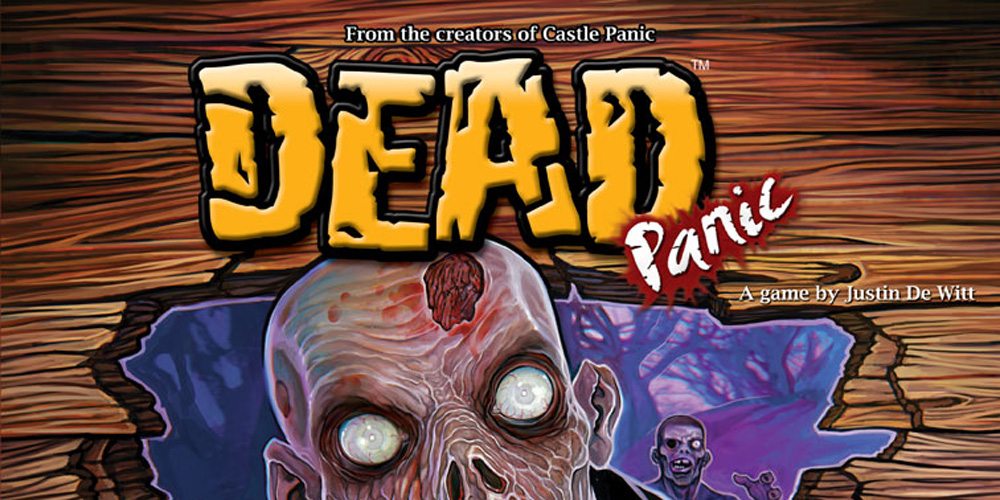On reflection, it probably wasn’t a great idea to spend a weekend in an abandoned hunting cabin with a cop, a convict, and a priest. Talk about awkward conversations. And that was before the zombies started showing up. In Dead Panic, you’ll try to hold off the zombies long enough to assemble a radio so you can call for rescuers.
At a glance: Dead Panic is a cooperative game for 2 to 6 players, ages 13 and up, and takes about 90 minutes to play. It retails for $39.95. In case you’re familiar with Castle Panic, this one is slightly more complex, but I think the age rating has as much to do with the theme as the gameplay. My own kids aren’t fans of zombies and shy away from the gruesome cover art.
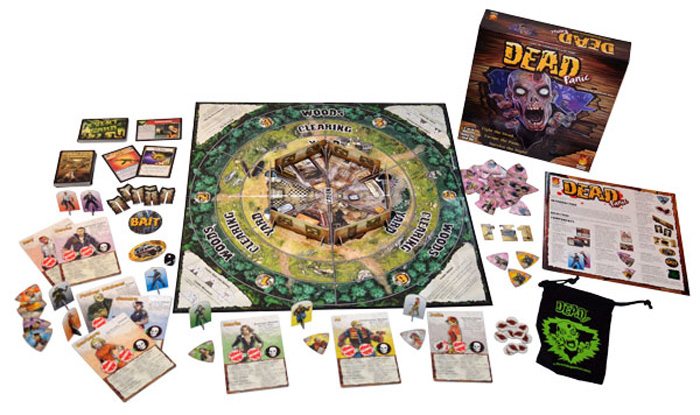
Components:
- 1 game board
- 29 Cabin cards
- 23 Event cards
- 8 player boards
- 8 character tokens with stands
- 24 zombie tokens
- 3 survivor tokens
- 8 character zombie tokens
- 12 injury tokens
- 6 cabin walls with stands
- 6 crack tokens
- 3 radio piece tokens
- 1 rescuer van token
- 1 Bait token
- 1 zombie draw bag
- 2 6-sided dice
The component quality is fairly good—a large quad-fold board, thick cardboard player boards and tokens. The cards aren’t the highest quality cardstock but work fine. One thing I noticed about the player tokens and walls is that some of the stands can come loose when you pick it up—mostly on the walls, though, which are usually only removed and not placed back.
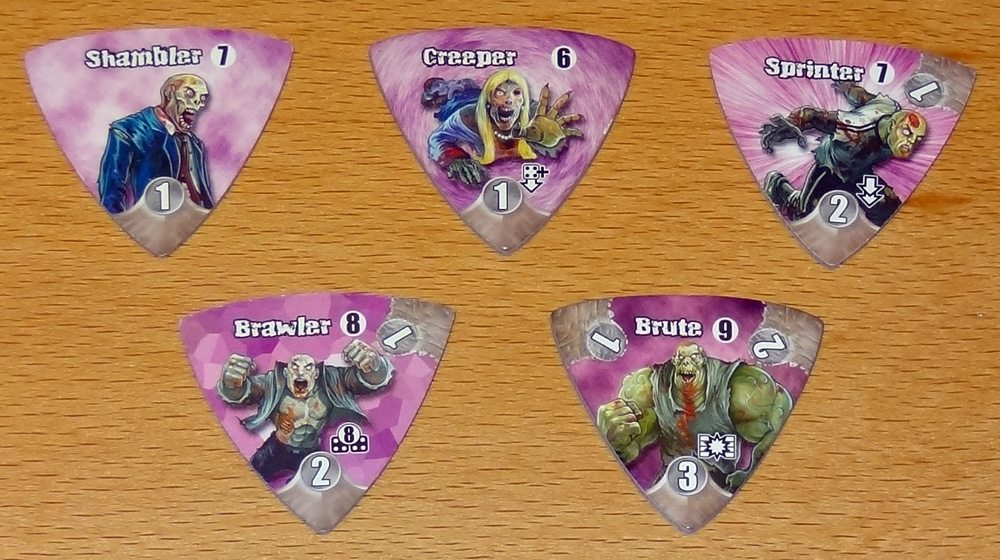
The zombie tokens, like the Castle Panic monsters, are triangular shapes with numbers on some of the corners. The corner facing the center of the board is the number of hit points the zombie has, and each time one is damaged, the tile is rotated down one number. When it is reduced to zero hit points, it is killed and removed.
The artwork for Dead Panic by Victor Perez Corbello is, as you might expect, a little more horrific than Castle Panic. The zombies here aren’t meant to be cute, and you’re not going to be fighting them off with mere plants. Each character has a zombie form, too, if they succumb to the walking dead.
How to play
You can download a copy of the rules here.
The goal of the game is to collect and assemble the 3 radio pieces, signal the rescuers, and make it into the van. If, however, you die, you turn into a zombie and attempt to kill off your former teammates.
To set up, each player takes a character board and places the corresponding pawn inside the cabin in the center of the board, rolling a die to see which of the six rooms to start in. The cabin walls are placed around the cabin. All of the zombie tiles are placed into the bag and shuffled, and six are drawn at random and placed, one in each arc, in the “Woods” section (farthest from the cabin). The Survivor tokens are now added to the bag as well and mixed in. The Cabin and Event cards are shuffled separately and set aside, along with all the various other tokens. The starting player takes the Bait token.
On each round, each player takes two actions. Then, after all players have acted, you draw and resolve an Event card, which adds more zombies. Then the zombies move, and anyone who is now in the same space as a zombie must fight. Finally, the Bait token is passed to the left.
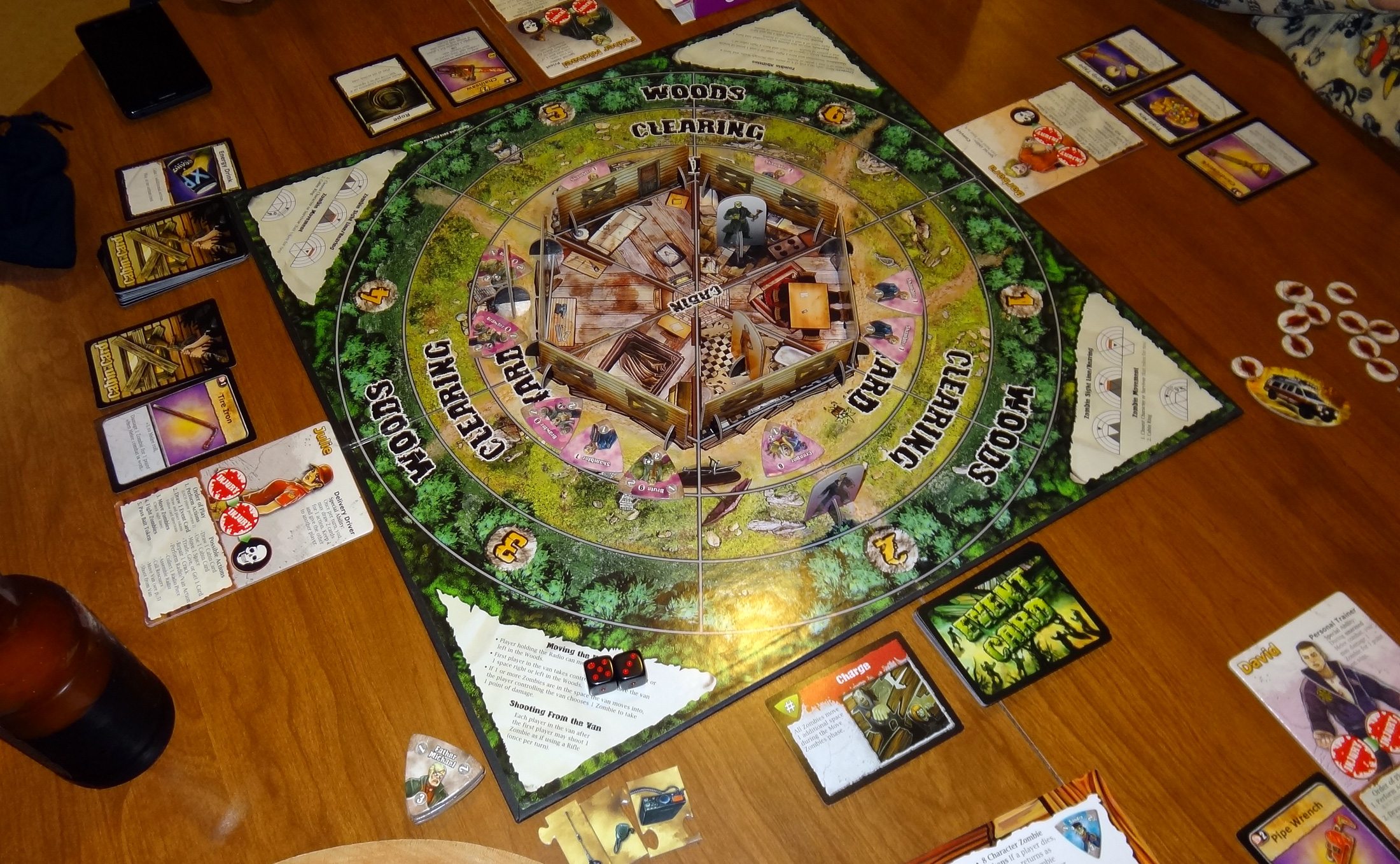
The actions available to you are:
- Move 1 space—in any direction (but not diagonally). If you move into a space with zombies, you must fight the strongest one immediately as part of your move.
- Draw 1 Cabin card—if you’re in the cabin, you may search for items.
- Use 1 Cabin card
- Trade items—you may give, receive, or trade 1 item with another character in your space
- Repair 1 Crack—if you’re next to a wall that is damaged, you may remove 1 crack from that wall
- Collect 1 Radio Piece—If you are in the same space as a radio piece, whether it is being carried by a Survivor or just on the ground, you may pick it up.
- Assemble Radio—If you have 2 or 3 Radio pieces, you may use an action to put them together; an assembled radio counts as a single item rather than 2 or 3.
- Call Rescuers—If you have the assembled radio, roll 1 die and place the van in the Woods arc corresponding to that number.
- Move Van—Once per turn, the player with the radio may move the van left or right 1 space. Once a player has reached the van, that player may drive the van 1 space.
- Shoot from Van—All other players who make it to the van may shoot 1 zombie once per turn from the van.
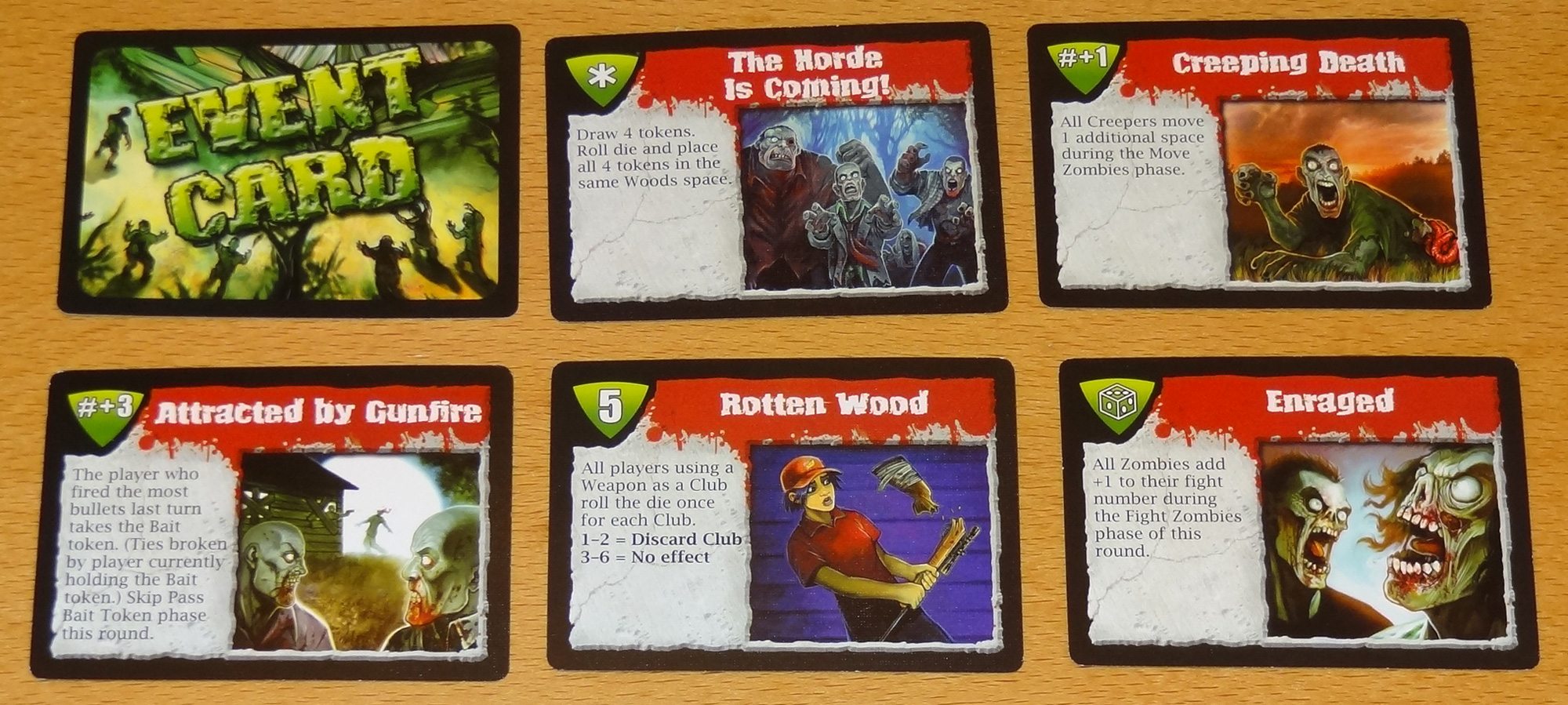
Once every player has had their two actions, you draw an Event card. The symbol in the green triangle indicates how many zombies to draw from the bag. A # symbol means the number of players, a die means you roll the die to determine the number, and the * means that you should check the card effect. In addition, there are other effects, from extra movement by certain types of zombies to running out of ammo.
Then, the zombies move. Typically each zombie moves 1 space, but there are Sprinters that move two spaces and Creepers that only move on a roll of 4 or higher. Unlike Castle Panic, the zombies do not simply move inward toward the cabin each round—if there’s a player or a Survivor in their line of sight, they’ll move that way instead. There are some diagrams and an if-then chart in the rulebook to explain the line-of-sight and which way zombies will move in certain instances. Generally, though, they move toward the closest human they can see, and toward the cabin otherwise. The Bait token is used to break ties.
Zombies can also break walls—the first time zombies hit a wall, you put a crack on it. The second time it is hit, the wall is destroyed and removed from the board. While losing all of the cabin walls doesn’t automatically make you lose the game, it does mean that the zombies can see you from farther away.
Finally, if you are in the same space as one or more zombies, you must fight.
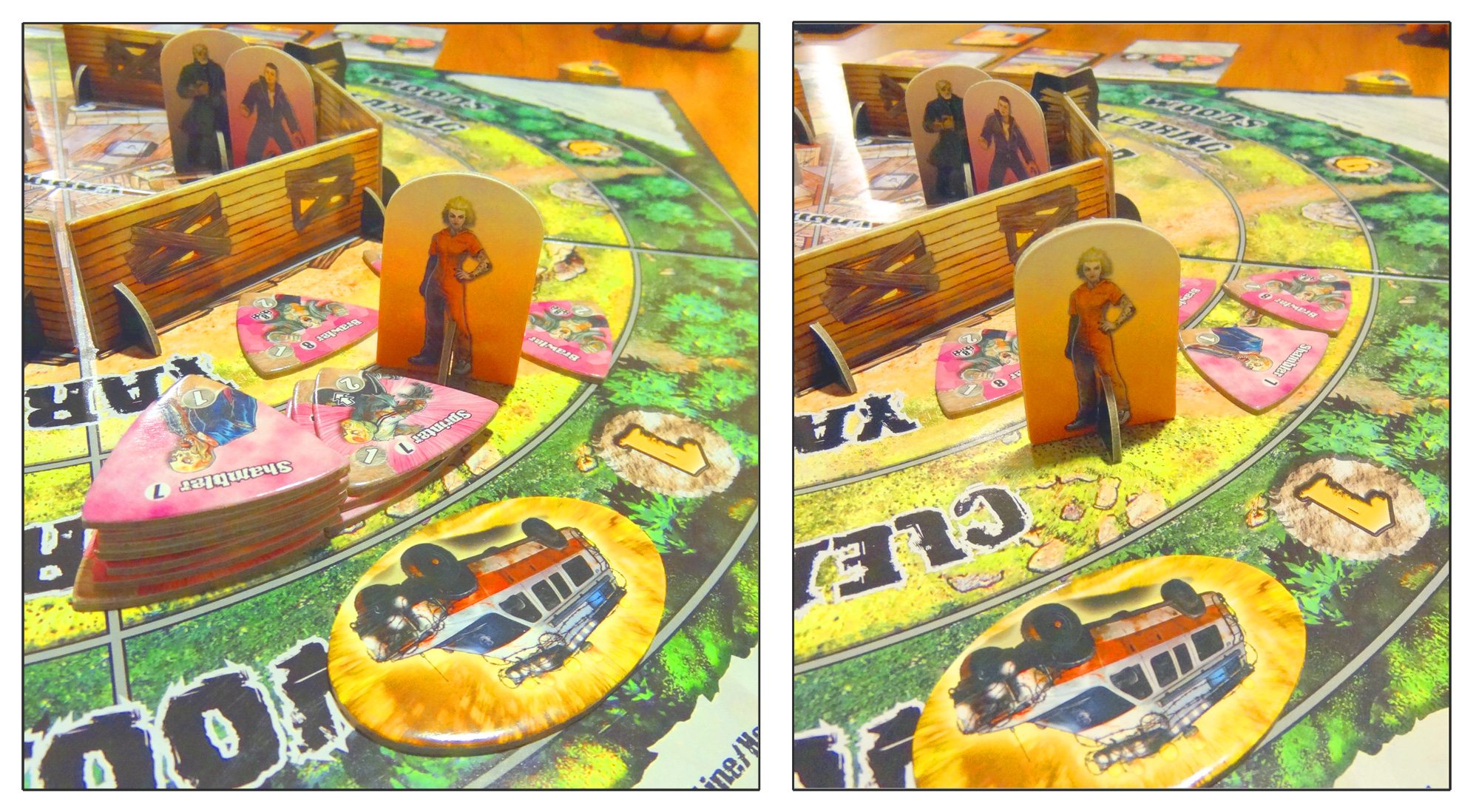
Each zombie has a fight value (next to the name)—you roll two dice and try to beat the fight value. If you have no weapons, all you can do is push the zombie one space away if you win. With weapons, you can damage or kill zombies, depending on what you’re using. Or, if you have a ranged weapon with ammo, you can just shoot the zombie instead of rolling dice to damage it. If your roll is equal to the zombie’s fight value, then nothing happens. If you roll less than the fight value, then you take an injury or sacrifice the weapon you used in the fight. When the injury marker moves to the skull on your player board, you die … and become a zombie.

There are a lot of different types of Cabin cards. Many of them are weapons, either melee weapons or ranged weapons. Melee weapons can be used any number of times, and often give some sort of bonus—more damage, a bonus to your fight rolls, the ability to re-roll, and so on. Ranged weapons have limited ammunition, and each time you fire them you’ll rotate the card to the next lower number. Once the ammo runs out, you flip the card over, and you can use it as a one-time club in a fight. There are other cards that will give you extra movement or actions, let you ignore all fights for one turn, or rebuild walls that were destroyed.
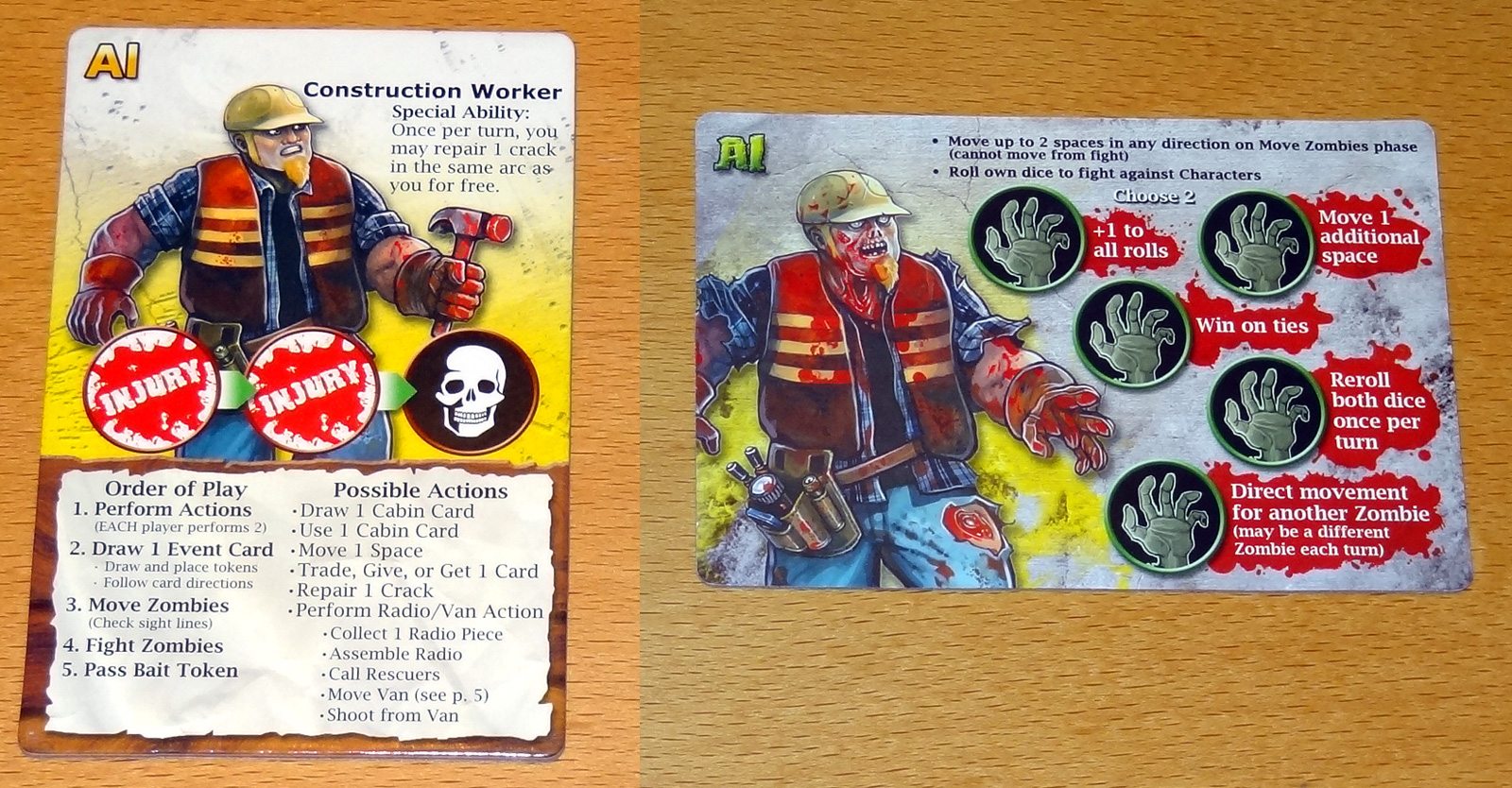
If you do end up getting three injuries, then you die and come back as a zombie. You lose all of your cards, flip over your player card, and pick two of the five abilities and mark them with injury tokens—these include increasing die rolls or re-rolling dice, directing movement for another zombie, winning on ties, and moving faster. Your character token is replaced with the zombie version, which has three health points. From now on, you get to move two spaces whenever the zombies move, and in fights you roll 2 dice to set your fight number.

You won’t be able to win the game, but maybe you can prevent your former teammates from winning. Serves them right for letting you get eaten.
Once each player has either gotten into the van or died, the game is over. Any players who made it to the van win the game.
There’s also a Zombie Overlord variant where one player controls the zombies and has a hand of 3 Event cards to choose from each turn. In addition, the Zombie Overlord gets to choose where to place new zombies rather than rolling the die, and also pick the direction of movement for the zombies rather than have them simply move toward the closest player.
There are also various ways to make the game easier or harder, or even make it a fully competitive game in which you can attack other players. There’s even a variant called “No Time for Grief”—when a character dies, you tip over the player marker and other players have the remainder of the round to shoot him before he turns into a zombie.
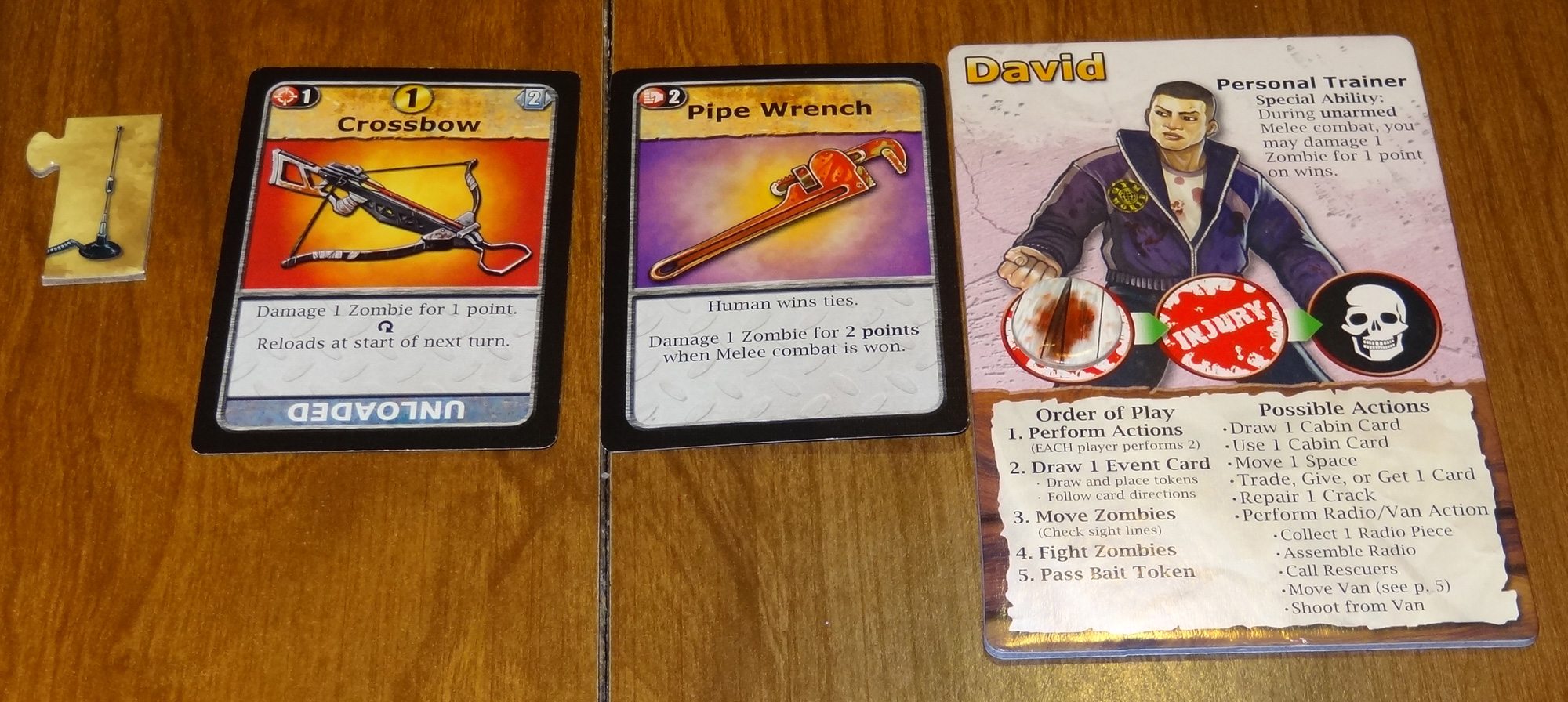
Oh, and in case you were wondering what each of the different characters do, here’s a list:
- Al the construction worker: repair 1 cracked wall for free
- Barbara the convict: hand size limit is 6 (instead of 5)
- David the personal trainer: can damage zombies even without a weapon
- Father Michael the priest: can give 1 of his actions to another player
- Julie the delivery driver: when searching, can draw 2 cards and give one to another player
- Maria the businesswoman: may trade with a player at any distance
- Sandra the police officer: may spend 2 bullets with one action
The Verdict
Dead Panic is sort of like a mash-up of Castle Panic, Fireside Games’ first title, and Last Night on Earth, one of my favorite zombie games. There are some significant differences, but it does kind of feel like a light version of Last Night on Earth, which has its pros and cons.
The board is set up like a ring, much like Castle Panic, but it doesn’t always feel like the game really needs to be on a round board other than for that symbolic tie to the earlier game. Yes, the zombies start in the outer ring and move inward, but only up to a point. Once they spot humans, they move based on line-of-sight, which can get really weird on a round board. On the plus side, I do like that in this game the players are actually characters that can move around (and, say, draw zombies away from the walls) rather than just the abstract (and invisible) castle defenders.
My kids won’t play this game—they’re younger than the recommended age limit anyway, and they’re creeped out by the cover art. So it’s really not one for little kids unless they happen to be into zombies. But for my adult gamers, I think I prefer the deeper experience (and look) of Last Night on Earth. The two games have enough similarities that I don’t feel I really need both of them in my collection.
However, one advantage to Dead Panic is that it is a simpler game to learn than Last Night on Earth. It is a much simpler game with fewer special situations, and so the game is quicker to learn, to set up, and to play. That alone may make it more likely for you to actually break it out on a game night.
The game scales pretty nicely, meaning that the difficulty level stays pretty similar no matter how many players you have, since many of the Event cards are based on the number of players. However, I do think it’s not too difficult in its default mode to win, or at least rescue some of the survivors. Saving everyone can be trickier, but I don’t think I’m likely to lose all of the players unless I throw in some extra difficulty options.
In my opinion, Dead Panic sort of straddles the middle ground between a kid-friendly cooperative game and an adults-only horror game, but I’m not sure I actually need that. I suppose if my kids were wanting to play zombie games I’d be more likely to play Dead Panic than Last Night on Earth, but since they’re not interested it’s not really for me. However, if you’ve got tweens who are into horror, it might be right up your alley. However, for younger (or more squeamish) kids, I’d recommend sticking with Castle Panic and then throwing in the Wizard’s Tower expansion when you’re ready for more.
For more about Dead Panic, visit the Fireside Games website. It’s also available from Amazon.
Disclosure: GeekDad received a review copy of this game.
